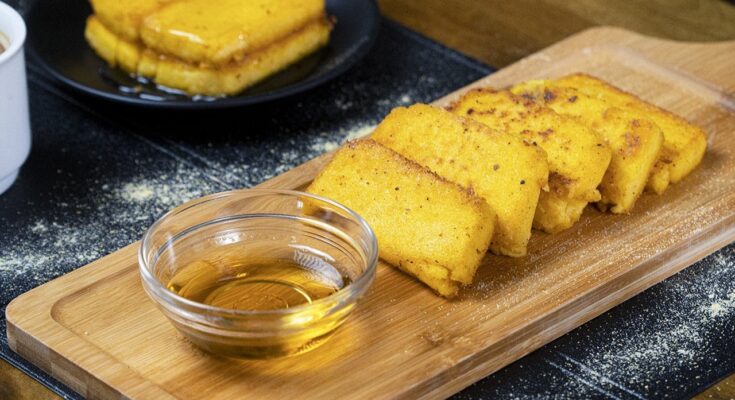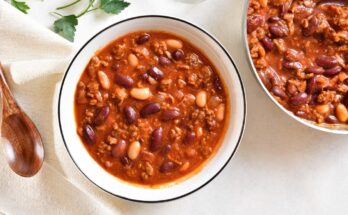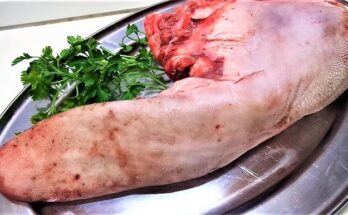Cornmeal Mush Recipe: Cornmeal mush is one of those timeless comfort foods that feels like a warm hug in a bowl. At its core, it’s simply cornmeal cooked in water or milk until it thickens into a creamy, porridge-like consistency. For many families, it’s not just food—it’s tradition. Some eat it hot for breakfast with a drizzle of honey or syrup, while others let it cool and slice it for frying later. It’s simple, budget-friendly, and endlessly versatile.
A Brief History of Cornmeal Mush
Cornmeal mush has been a staple dish in American kitchens since colonial times. Native Americans were the first to grind corn into meal and cook it into nourishing porridge, and early settlers quickly adopted this practice. Over time, it became a household favorite, especially during the Great Depression, when affordable and filling meals were essential. Interestingly, cornmeal mush has cousins all around the world—like polenta in Italy and mamaliga in Romania. Each culture adds its own twist, but the foundation remains the same: cornmeal, water, and patience.
Why You’ll Love This Recipe
What makes cornmeal mush so beloved is its versatility. It can be sweet or savory, soft or firm, and it pairs beautifully with a variety of toppings. You can enjoy it hot with butter and sugar, serve it alongside hearty stews, or let it chill and fry it for a crispy side dish. It’s also gluten-free by nature, making it an excellent choice for anyone with dietary restrictions. Whether you’re craving comfort food, looking for a simple side, or exploring old-fashioned recipes, cornmeal mush fits the bill perfectly.
Ingredients You’ll Need
Essential Ingredients
To prepare a traditional batch of cornmeal mush, you’ll need just a handful of basic ingredients:
- Cornmeal – The star of the show. Choose medium or coarse ground for best results.
- Water – Used as the cooking base.
- Salt – Just a pinch enhances flavor.
That’s it! With just these three, you can create the simplest, most authentic cornmeal mush.
Optional Ingredients for Extra Flavor
Want to take things up a notch? You can enhance your cornmeal mush with:
- Butter – Adds richness and creaminess.
- Milk – Replaces part of the water for a smoother texture.
- Sugar or Honey – For a touch of sweetness.
- Maple Syrup – A classic topping for breakfast versions.
- Cheese – Stir in grated cheddar for a savory twist.
- Herbs and Spices – Garlic powder, black pepper, or paprika can give depth to the flavor.
Ingredient Substitutions and Variations
If you don’t have traditional cornmeal, you can substitute with:
- Polenta Cornmeal – Similar texture, slightly different grind.
- Stone-Ground Cornmeal – Brings a rustic, hearty feel.
- Gluten-Free Cornmeal Blends – Ideal for sensitive diets.
For vegan variations, use plant-based milk and dairy-free butter. For richer flavor, swap half the water for broth. This flexibility makes cornmeal mush one of the most adaptable recipes you can have in your kitchen.
Tools and Equipment Required
Cooking Tools You Should Have
Cooking cornmeal mush doesn’t require fancy gadgets—just the basics:
- A Medium or Large Saucepan – To cook the mush evenly.
- A Whisk – Essential to prevent lumps when stirring in cornmeal.
- A Wooden Spoon – Great for stirring as the mixture thickens.
- Measuring Cups and Spoons – To keep ingredient ratios right.
Serving Tools for Presentation
How you serve cornmeal mush depends on your preference:
- Bowls and Spoons – For hot, creamy servings.
- Loaf Pan or Dish – If you want to let it set, then slice later.
- Skillet – For frying leftover mush slices until golden and crispy.
Having the right tools on hand makes cooking smooth and cleanup easy.
Step-by-Step Guide to Making Cornmeal Mush
Step 1 – Gather All Ingredients
Before you begin, make sure you’ve got everything ready. Measure out your cornmeal, salt, and water (or milk). This step may sound simple, but it’s crucial. Having everything prepared avoids mistakes—especially since once the water boils, you’ll need to move quickly. If you’re planning on adding butter, sugar, or other extras, keep them nearby for easy access.
Step 2 – Boil the Water
Start by bringing water to a boil in a medium saucepan. Add a pinch of salt for flavor. If you’re using milk or broth, mix it with the water at this stage. Be sure to keep an eye on it—boiling water can quickly bubble over if left unattended.
Step 3 – Mix Cornmeal and Cold Water
Here’s a little trick: instead of dumping dry cornmeal straight into boiling water (which almost always creates lumps), whisk your cornmeal with a small amount of cold water first. This slurry ensures a smooth consistency once added to the hot liquid.
Step 4 – Stir into Boiling Water
Slowly pour the cornmeal slurry into the boiling water while whisking constantly. This prevents clumping and keeps your mush silky smooth. Once it’s all in, reduce the heat to low.
Step 5 – Simmer Until Thickened
Let the mixture simmer gently, stirring often with a wooden spoon. As it cooks, it will thicken into a porridge-like texture. Depending on your cornmeal grind, this can take anywhere from 20 to 30 minutes. Be patient—slow cooking develops the best flavor and texture.
Step 6 – Serve Hot or Let It Set
At this point, you can serve the mush hot in bowls, topped with butter, sugar, or syrup. Or, you can pour it into a loaf pan, let it cool, and refrigerate it. Once firm, slice it and fry the pieces for a crispy, golden treat.
Serving Suggestions
Sweet Serving Options
For a breakfast-style mush, drizzle with honey, sprinkle cinnamon, or top with fresh fruit. Maple syrup is a classic choice, adding rich sweetness that pairs beautifully with corn. Some even enjoy a spoonful of jam or jelly mixed in for a fruity kick.
Savory Serving Ideas
Cornmeal mush isn’t just for sweet tooths—it shines in savory dishes too. Serve it alongside scrambled eggs, bacon, or sausage for a hearty breakfast. At dinner, pair it with chili, stews, or roasted vegetables. Add cheese while cooking for a creamy, savory twist that resembles polenta.
Breakfast vs. Dinner Uses
What’s great about cornmeal mush is its ability to adapt to any meal. In the morning, it’s warm and comforting, while at night, it transforms into a versatile side dish or even a main course when topped with sauce, beans, or sautéed greens.
Storage and Reheating Tips
How to Store Cornmeal Mush Properly
One of the best things about cornmeal mush is that it stores well, making it a handy make-ahead dish. If you’ve made a big batch and don’t plan on eating it all at once, simply transfer the leftovers into an airtight container. If you poured the mush into a loaf pan to set, cover it tightly with plastic wrap or foil. Place it in the refrigerator, and it will stay fresh for up to four to five days. For longer storage, you can even freeze cornmeal mush. To do this, let it cool completely, slice it into portions, and wrap each slice individually in parchment paper before sealing in a freezer bag. This way, you can pull out just what you need without thawing the entire batch.
Best Ways to Reheat Without Losing Texture
When reheating cornmeal mush, texture is everything. If you’re working with mush that was stored soft and creamy, transfer it to a saucepan and warm it over low heat. Add a splash of milk or water, then stir gently until it regains its smooth consistency. If you’re reheating slices that were set in the fridge, the skillet is your best friend. Simply heat a little butter or oil in the pan and fry the slices until golden brown on both sides. This not only heats them up but also gives them a satisfying crispy crust. Avoid using the microwave if possible—it tends to make mush rubbery or unevenly heated.
Health Benefits of Cornmeal Mush
Nutritional Value
Cornmeal mush isn’t just filling—it’s nutritious too. Cornmeal is a whole grain that provides a healthy dose of carbohydrates for energy, along with fiber that aids digestion. It’s also a good source of essential minerals like iron, magnesium, and phosphorus. A single serving delivers key nutrients without being overly heavy, making it a wholesome choice for breakfast, lunch, or dinner. Plus, since it’s naturally low in fat and can be prepared without added sugar, it fits into a balanced diet with ease.
Gluten-Free and Dietary Benefits
For anyone avoiding gluten, cornmeal mush is a dream dish. Since corn is naturally gluten-free, this recipe is safe for people with celiac disease or gluten sensitivity. It’s also highly customizable—you can keep it vegan by using plant-based milk and butter substitutes, or make it more protein-rich by adding cheese or serving it alongside beans or meat. The versatility of cornmeal mush means it can fit into a wide range of dietary preferences, from low-fat diets to high-protein lifestyles.
Common Mistakes to Avoid
Preventing Lumps in Cornmeal Mush
If you’ve ever made porridge and ended up with stubborn lumps, you know how frustrating it can be. The same goes for cornmeal mush—once lumps form, they’re nearly impossible to fix. The secret? Always whisk your cornmeal with cold water first to make a slurry before adding it to boiling water. Then, stir constantly when incorporating it into the hot liquid. A whisk works best at the beginning, while a wooden spoon is perfect for stirring as it thickens. Remember, slow and steady wins the race—rushing this step almost guarantees lumps.
Avoiding Overcooking or Burning
Cornmeal mush requires patience. Cooking it on too high a heat or neglecting to stir it regularly can cause it to stick to the bottom of the pot and burn. Burnt mush not only ruins the flavor but also makes cleanup a nightmare. To avoid this, keep the heat low once the cornmeal has been added, and stir frequently. Using a heavy-bottomed saucepan helps distribute heat evenly, reducing the risk of scorching. If you want perfectly smooth, creamy mush, treat it gently and give it the time it needs.
Variations of Cornmeal Mush Around the World
Polenta in Italy
In Italy, cornmeal mush takes on a new identity as polenta, a beloved dish in Northern Italian cuisine. Like traditional mush, polenta starts with cornmeal and water but is often enriched with butter, cream, or cheese for a luxurious texture. Italians serve it soft and creamy, paired with meats, stews, or sautéed vegetables. Alternatively, they allow it to set, slice it, and grill or fry it, much like the American style. The difference is in the seasoning—polenta often includes parmesan cheese and herbs, making it richer and more savory.
Similar Dishes in Other Cultures
Cornmeal mush may be American at heart, but variations exist worldwide. In Romania, a dish called mămăligă closely resembles polenta and is a staple alongside meats and cheeses. In Africa, many countries prepare cornmeal porridge, often served at breakfast with milk and sugar. In the Caribbean, cornmeal porridge is sweetened with condensed milk, nutmeg, and vanilla, creating a flavorful twist. Each culture adapts the dish to local tastes, proving that cornmeal is truly a global ingredient with endless potential.
FAQs about Cornmeal Mush Recipe
1. What’s the difference between cornmeal mush and polenta?
They’re very similar, but polenta is the Italian version, often richer with added cheese, butter, or cream, while mush tends to be simpler and more rustic.
2. Can I make cornmeal mush in advance?
Yes! You can prepare it, let it cool in a loaf pan, and refrigerate it. Later, slice and fry it for a delicious meal.
3. What toppings go best with cornmeal mush?
Sweet toppings like honey, syrup, or fruit are great for breakfast, while cheese, gravy, or sautéed vegetables work well for savory meals.
4. Is cornmeal mush healthy for weight loss?
It can be! Since it’s low in fat and high in fiber, it helps keep you full without piling on calories—just watch your toppings.
5. Can I fry leftover cornmeal mush?
Absolutely! In fact, frying is one of the best ways to enjoy leftovers. Slice the chilled mush and fry until crispy and golden.
Conclusion
Cornmeal mush is the kind of recipe that proves simple food can be the most satisfying. With just a handful of ingredients—cornmeal, water, and salt—you can create a dish that’s comforting, versatile, and steeped in history. Whether you like it creamy and sweet for breakfast, savory with cheese for dinner, or sliced and fried the next day, cornmeal mush adapts to your taste and lifestyle. It’s budget-friendly, family-friendly, and downright delicious. If you’ve never tried making it at home, now’s the perfect time to bring this old-fashioned favorite back to your kitchen.



